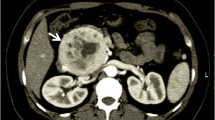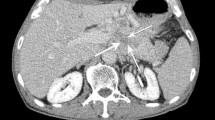Abstract
Purpose
To retrospectively determine whether enhancement patterns in the pancreatic and equilibrium phases of computed tomography (CT) for pancreatic neuroendocrine neoplasms are related to prognostic factors of surgical and endoscopic ultrasound-guided fine-needle aspiration biopsy specimens.
Methods
Twenty-five pancreatic neuroendocrine neoplasms in 22 patients underwent preoperative dynamic CT. Tumors were classified into two groups by enhancement patterns on preoperative CT. A washout pattern was defined as peak enhancement in the pancreatic phase with washout of at least 60 Hounsfield units in the equilibrium phase. Group 1 comprised tumors showing a washout pattern in more than half of tumor and Group 2 comprised tumors showing a washout pattern in less than half of the tumor. The Ki-67 index and the presence of vascular invasion were evaluated in surgical specimens. The Ki-67 index from biopsy specimens was compared with that from surgical specimens.
Results
There were 12 surgical specimens in Group 1 and 13 in Group 2. Group 2 showed significant correlations with larger Ki-67 indices (p < 0.05) and positive vascular invasion (p < 0.05). The Ki-67 index discrepancy between biopsy and surgical specimens of Group 2 was significantly greater than that of Group 1 (p < 0.05).
Conclusions
Pancreatic neuroendocrine neoplasms in which less than half of the tumor showed a washout pattern were correlated with poor prognostic factors. Analysis of enhancement patterns may provide predictive information about whether endoscopic ultrasound-guided fine-needle aspiration biopsy is reliable for the assessment of Ki-67 index.





Similar content being viewed by others

References
Klimstra DS, Capella C, Arnold R (2010) Neuroendocrine neoplasms of the pancreas. In: Bosman FT, Carneiro F, Hruban RH, et al. (eds) WHO Classification of Tumours of the Digestive System, 4th edn. Lyon, France: IARC Press, pp 322–326
Deshpande V, Fernandez-del Castillo C, Muzikansky A, et al. (2004) Cytokeratin 19 is a powerful predictor of survival in pancreatic endocrine tumors. Am J Surg Pathol 28:1145–1153
Schmitt AM, Anlauf M, Rousson V, et al. (2007) WHO 2004 criteria and CK19 are reliable prognostic markers in pancreatic endocrine tumors. Am J Surg Pathol 31:1677–1682
Horton KM, Hruban RH, Yeo C, Fishman EK (2006) Multi-detector row CT of pancreatic islet cell tumors. Radiographics 26:453–464
Rha SE, Jung SE, Lee KH, et al. (2007) CT and MR imaging findings of endocrine tumor of the pancreas according to WHO classification. Eur J Radiol 62:371–377
Lewis RB, Lattin GE Jr, Paal E (2010) Pancreatic endocrine tumors: radiologic-clinicopathologic correlation. Radiographics 30:1445–1464
Hayashi D, Tkacz JN, Hammond S, et al. (2011) Gastroenteropancreatic neuroendocrine tumors: multimodality imaging features with pathological correlation. Jpn J Radiol 29:85–91
Ichikawa T, Peterson MS, Federle MP, et al. (2000) Islet cell tumor of the pancreas: biphasic CT versus MR imaging in tumor detection. Radiology 216:163–171
Rodallec M, Vilgrain V, Couvelard A, et al. (2006) Endocrine pancreatic tumours and helical CT: contrast enhancement is correlated with microvascular density, histoprognostic factors and survival. Pancreatology 6:77–85
d’Assignies G, Couvelard A, Bahrami S, et al. (2009) Pancreatic endocrine tumors: tumor blood flow assessed with perfusion CT reflects angiogenesis and correlates with prognostic factors. Radiology 250:407–416
Hattori Y, Gabata T, Matsui O, et al. (2009) Enhancement patterns of pancreatic adenocarcinoma on conventional dynamic multi-detector row CT: correlation with angiogenesis and fibrosis. World J Gastroenterol 15:3114–3121
La Rosa S, Klersy C, Uccella S, et al. (2009) Improved histologic and clinicopathologic criteria for prognostic evaluation of pancreatic endocrine tumors. Hum Pathol 40:30–40
Rindi G, Klöppel G, Couvelard A, et al. (2007) TNM staging of midgut and hindgut (neuro) endocrine tumors: a consensus proposal including a grading system. Virchows Arch 451:757–762
Herwick S, Miller FH, Keppke AL (2006) MRI of islet cell tumors of the pancreas. AJR Am J Roentgenol 187:W472–W480
Micke P, Ostman A (2005) Exploring the tumour environment: cancer-associated fibroblasts as targets in cancer therapy. Expert Opin Ther Targets 9:1217–1233
Hwang RF, Moore T, Arumugam T, et al. (2008) Cancer-associated stromal fibroblasts promote pancreatic tumor progression. Cancer Res 68:918–926
Aranha GV, Georgen R (1989) Gastric linitis plastica is not a surgical disease. Surgery 106:758–762
Amorn Y, Knight WA Jr (1978) Primary linitis plastica of the colon: report of two cases and review of the literature. Cancer 41:2420–2425
Dawson PJ, Karrison T, Ferguson DJ (1986) Histologic features associated with long-term survival in breast cancer. Hum Pathol 17:1015–1021
Asayama Y, Yoshimitsu K, Irie H, et al. (2006) Delayed-phase dynamic CT enhancement as a prognostic factor for mass-forming intrahepatic cholangiocarcinoma. Radiology 238:150–155
Marion-Audibert AM, Barel C, Gouysse G, et al. (2003) Low microvessel density is an unfavorable histoprognostic factor in pancreatic endocrine tumors. Gastroenterology 125:1094–1104
Couvelard A, O’Toole D, Turley H, et al. (2005) Microvascular density and hypoxia-inducible factor pathway in pancreatic endocrine tumours: negative correlation of microvascular density and VEGF expression with tumour progression. Br J Cancer 92:94–101
Takahashi Y, Akishima-Fukasawa Y, Kobayashi N, et al. (2007) Prognostic value of tumor architecture, tumor-associated vascular characteristics, and expression of angiogenic molecules in pancreatic endocrine tumors. Clin Cancer Res 13:187–196
Ekeblad S, Skogseid B, Dunder K, et al. (2008) Prognostic factors and survival in 324 patients with pancreatic endocrine tumor treated at a single institution. Clin Cancer Res 14:7798–7803
Pape UF, Jann H, Müller-Nordhorn J, et al. (2008) Prognostic relevance of a novel TNM classification system for upper gastroenteropancreatic neuroendocrine tumors. Cancer 113:256–265
Strosberg J, Nasir A, Coppola D, Wick M, Kvols L (2009) Correlation between grade and prognosis in metastatic gastroenteropancreatic neuroendocrine tumors. Hum Pathol 40:1262–1268
Yang Z, Tang LH, Klimstra DS (2011) Effect of tumor heterogeneity on the assessment of Ki67 labeling index in well-differentiated neuroendocrine tumors metastatic to the liver: implications for prognostic stratification. Am J Surg Pathol 35:853–860
Figueiredo FA, Giovannini M, Monges G, et al. (2009) EUS-FNA predicts 5-year survival in pancreatic endocrine tumors. Gastrointest Endoscopy 70:907–914
Acknowledgment
We thank Mami Gyouba and Yuka Mori for their contributions in the preparation of pathologic data.
Conflicts of interest
The authors have no conflicts of interest to declare.
Author information
Authors and Affiliations
Corresponding author
Rights and permissions
About this article
Cite this article
Tatsumoto, S., Kodama, Y., Sakurai, Y. et al. Pancreatic neuroendocrine neoplasm: correlation between computed tomography enhancement patterns and prognostic factors of surgical and endoscopic ultrasound-guided fine-needle aspiration biopsy specimens. Abdom Imaging 38, 358–366 (2013). https://doi.org/10.1007/s00261-012-9953-8
Published:
Issue Date:
DOI: https://doi.org/10.1007/s00261-012-9953-8



